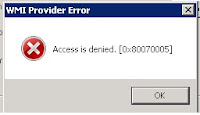1. Error:
Cannot connect to WMI provider. You do not have permission or the server is unreachable. Note that you can only manage SQL Server 2005 servers with SQL Server Configuration Manager.
Invalid class [0x80041010]
Above error will appear while opening SQL server configuration manager, if some of the Managed Object Format (.mof) files are not installed properly and registered during the SQL Server installation.
The solution is to register the missing .mof files using mofcomp.
Run the below command in cmd prompt.
For 64bit SQL
C:\Program Files (x86)\Microsoft SQL Server\100\Shared>mofcomp "C:\Program Files
(x86)\Microsoft SQL Server\100\Shared\sqlmgmproviderxpsp2up.mof"
For 32bit SQL
C:\Program Files\Microsoft SQL Server\100\Shared>mofcomp "C:\Program Files\Microsoft SQL Server\100\Shared\sqlmgmproviderxpsp2up.mof"
Output would be something like below.
Microsoft (R) 32-bit MOF Compiler Version 5.1.2600.2180
Copyright (c) Microsoft Corp. 1997-2001. All rights reserved.
Parsing MOF file: C:\Program Files\Microsoft SQL Server\100\Shared\sqlmgmprovider
xpsp2up.mof
MOF file has been successfully parsed
Storing data in the repository...
Done!
If you run into any compilation error like - An error occurred while processing item 1 defined on lines 4 - 7 in file C:\Prog
ram Files (x86)\Microsoft SQL Server\100\Shared\sqlmgmproviderxpsp2up.mof:
0X80041002 Class, instance, or property 'Name' was not found.
Compiler returned error 0x80041002
follow the below steps.
1. Stop WMI service
2. Navigate to the folder “C:\Windows\System32\wbem” and rename the repository folder to repository_old
3. Rerun the same cmd again
C:\Program Files\Microsoft SQL Server\100\Shared>mofcomp "C:\Program Files\Microsoft SQL Server\100\Shared\sqlmgmproviderxpsp2up.mof"
-------------------------------------------------------------------------------------------------
2. Error Message:
WMI Provider Error: Access is denied. [0x80070005]
The best practice to update a service account password is through SQL Server Configuration Manager. But on Windows server 2008 you will see this error if UAC is enabled.
There is no solution that I am aware of, but here is the work around.
All we have to do is, click on the browse button to reselect the service account though it’s already listed, and then provide the pwd and click apply.



 The best practice to update a service account password is through SQL Server Configuration Manager. But on Windows server 2008 you will see this error if UAC is enabled.
The best practice to update a service account password is through SQL Server Configuration Manager. But on Windows server 2008 you will see this error if UAC is enabled.